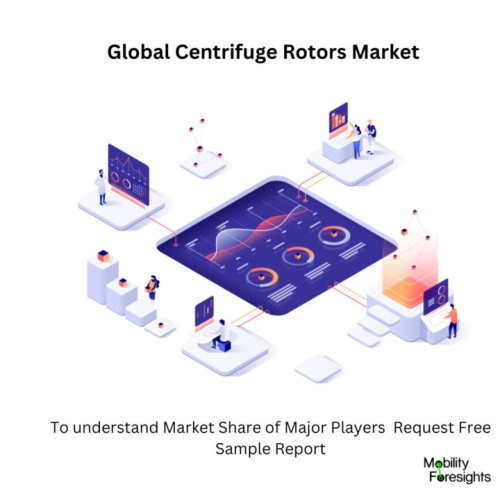
- Get in Touch with Us

Last Updated: Apr 25, 2025 | Study Period: 2024-2030
The revolving component of a centrifuge, which has fixed holes bored at an angle, is called a centrifuge rotor. The rotor spins as test tubes are inserted into these holes to help separate the materials.
Swing-bucket, fixed-angle, and vertical rotors are the three different types of centrifuge rotors. One crucial component of the apparatus is the centrifuge rotor, which controls not only the sample size but also how the particles move and disperse in the fluid after centrifugation.
Different materials are used to make centrifuge rotors. High-speed rotors are typically constructed of aluminum, titanium, or fiber-reinforced composites, while low-speed rotors are typically made of steel or brass.

The Global centrifuge rotors market accounted for $XX Billion in 2023 and is anticipated to reach $XX Billion by 2030, registering a CAGR of XX% from 2024 to 2030.
Centrifuge 5910 Ri, a brand-new centrifuge from Eppendorf, is intended to boost laboratory productivity.
The new centrifuge replaces the well-known Centrifuge 5910 R, the apex of the Eppendorf multipurpose centrifuge line that has been offering clients across the world with exceptional versatility and ease of use since its introduction.
Eppendorf provides scientists with cutting-edge capabilities to streamline and expedite the centrifugation processes of their workflow with the launch of Centrifuge 5910 Ri.
Three layers of user administration, new documentation choices, and an innovative touchscreen interface make it simple to configure the required parameters while enhancing security and traceability.
A wide range of applications are made possible by a large selection of rotors and adapters, and the special Universal rotor saves time by enabling the centrifugation of objects like plates, 250 mL bottles, and 50 mL conical tubes without the need to switch the rotor, rotor buckets, or adapters.
| Sl no | Topic |
| 1 | Market Segmentation |
| 2 | Scope of the report |
| 3 | Abbreviations |
| 4 | Research Methodology |
| 5 | Executive Summary |
| 6 | Introduction |
| 7 | Insights from Industry stakeholders |
| 8 | Cost breakdown of Product by sub-components and average profit margin |
| 9 | Disruptive innovation in the Industry |
| 10 | Technology trends in the Industry |
| 11 | Consumer trends in the industry |
| 12 | Recent Production Milestones |
| 13 | Component Manufacturing in US, EU and China |
| 14 | COVID-19 impact on overall market |
| 15 | COVID-19 impact on Production of components |
| 16 | COVID-19 impact on Point of sale |
| 17 | Market Segmentation, Dynamics and Forecast by Geography, 2024-2030 |
| 18 | Market Segmentation, Dynamics and Forecast by Product Type, 2024-2030 |
| 19 | Market Segmentation, Dynamics and Forecast by Application, 2024-2030 |
| 20 | Market Segmentation, Dynamics and Forecast by End use, 2024-2030 |
| 21 | Product installation rate by OEM, 2023 |
| 22 | Incline/Decline in Average B-2-B selling price in past 5 years |
| 23 | Competition from substitute products |
| 24 | Gross margin and average profitability of suppliers |
| 25 | New product development in past 12 months |
| 26 | M&A in past 12 months |
| 27 | Growth strategy of leading players |
| 28 | Market share of vendors, 2023 |
| 29 | Company Profiles |
| 30 | Unmet needs and opportunity for new suppliers |
| 31 | Conclusion |
| 32 | Appendix |